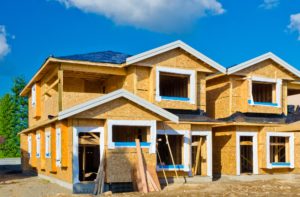Building electrification and decarbonization policies are being discussed by cities and states as well as in boardrooms across the country. Just last month, the U.S. Securities and Exchange Commission revealed a much-anticipated proposal to require public companies to disclose certain climate-related information. Meanwhile, Minnesota state lawmakers are considering a change that would allow cities to adopt the latest building energy codes before the state (for larger and commercial buildings only).
 We have long known that it is cheapest and easiest to electrify buildings, or make them “ready” for future electrification, at the time of construction. But a new report released this month by New Buildings Institute (NBI), with support from NRDC (Natural Resources Defense Council), provides valuable findings that confirm the potential savings. The report, “Cost Study of the Building Decarbonization Code,” analyzes the incremental first cost and life cycle cost of two common building types that follow the code language in NBI’s Building Decarbonization Code—a groundbreaking tool intended to deliver significant energy savings and low-carbon performance in new construction projects. The study analyzes both paths offered in the Building Decarbonization Code—all-electric (a building is powered only with electricity) and mixed-fuel (including natural gas or other fossil fuels such as propane or oil that is combusted on-site).
We have long known that it is cheapest and easiest to electrify buildings, or make them “ready” for future electrification, at the time of construction. But a new report released this month by New Buildings Institute (NBI), with support from NRDC (Natural Resources Defense Council), provides valuable findings that confirm the potential savings. The report, “Cost Study of the Building Decarbonization Code,” analyzes the incremental first cost and life cycle cost of two common building types that follow the code language in NBI’s Building Decarbonization Code—a groundbreaking tool intended to deliver significant energy savings and low-carbon performance in new construction projects. The study analyzes both paths offered in the Building Decarbonization Code—all-electric (a building is powered only with electricity) and mixed-fuel (including natural gas or other fossil fuels such as propane or oil that is combusted on-site).
Through an examination of a single-family prototype, the cost study found that all-electric homes achieve construction savings and mixed-fuel households are nominally more expensive. It also found only marginal additional first costs for property owners of the all-electric medium office building prototype, with most of the first costs of the Building Decarbonization Code attributed to electric vehicle charging infrastructure. Additionally, researchers determined that life cycle cost analysis (LCCA) for the single-family prototypes produced both economic and societal benefits. These are significant findings for jurisdictions considering adopting the Building Decarbonization Code and informs the potential impact on construction costs and opportunities for savings as they work to transition away from fossil fuel combustion in buildings.
For this study, researchers used cost data from New York State, a relatively expensive market in Climate Zone 5A, a relatively cold climate. There are currently 21 U.S. states that contain cities and counties in climate zone 5A, making the findings applicable across a broad area of the country. At the end of the report (and this blog) are our recommendations to jurisdictions considering adopting electrification or electrification-ready measures in their next code cycle.
Key Findings of the Cost Study of the Decarbonization Code

Most significant for the climate, the study found that the carbon emissions impact of building electrification is six times that of the electric-ready scenarios, saving 126.2 MT of Co2e. Other key findings include:
- All-electric single-family homes built to meet the Building Decarbonization Code are $7,500-$8,200 cheaper to construct than baseline code homes in the study area.
- All-electric medium office buildings in the study area are only slightly more expensive ($0.33-0.50/sf) to construct compared to baseline code office buildings.
- The avoided cost of not installing fossil-fuel infrastructure is a key factor supporting the cost effectiveness of the all-electric pathway.
- Electrifying during new construction is far more cost effective than implementing electrification readiness. (Electric-ready construction allows for simple, low-cost all-electric technology installation at some point in the future).
- Still, electric-ready construction saves the homeowner thousands of dollars compared to retrofitting to accommodate electric equipment replacements.
- The all-electric single-family scenario reduced total energy consumption by 34%, while the mixed-fuel scenario reduced energy consumption by 9% compared to the baseline. However, all-electric can still result in higher utility bills due to the high cost of electricity compared to natural gas in the study area.
- This leads us to conclude that electrification is more cost effective in areas that have time-of-use rates (i.e. where electricity rates fluctuate based on demand).
- Where climates are warmer and/or electricity costs are more affordable than the 5A climate zone of New York state, both the operating and life cycle costs of decarbonizing will be better than the results of this study.
A regional study with national reach
NBI’s Building Decarbonization Code is an overlay that’s compatible with the 2021 International Energy Conservation Code (IECC) and ASHRAE Standard 90.1— offering code language for both residential and commercial new construction that’s intended to help reduce the amount of carbon being emitted from buildings. The Buildings Decarbonization Code addresses the direct, on-site fossil fuel consumption of buildings and prepares buildings for the shift toward a cleaner electric grid.
While this examination of the cost impacts of the Building Decarbonization Code looks at specific scenarios in one climate zone, it was designed to establish a methodology that can be expanded to analyze additional building typologies, climate zones, and geographic areas. And the results give positive indications that future studies will conclude that the all-electric and mixed-fuel versions of the Building Decarbonization Code are cost effective elsewhere.
Recommendations
Based on the findings of this study, NBI recommends the following:
- All jurisdictions in climate zone 5A with utility costs within the ranges presented in the study adopt all-electric single-family home provisions for new construction, with the inclusion of electric vehicle charging equipment requirements.
- All jurisdictions in climate zone 5A adopt all-electric commercial office provisions for new construction, strongly considering the inclusion of electric vehicle charging equipment requirements to mitigate future costs of electrifying the transportation sector.
- Similar cost effectiveness studies be applied to additional climate zones and building types to analyze the potential savings of these code provisions in additional geographies and applications.
Questions about the report or its findings? Please contact [email protected]. To learn more about the Building Decarbonization Code and find resources for adoption, visit newbuildingsin.wpenginepowered.com/resource/building-decarbonization-code.
View Cost Study of the Building Decarbonization CodeTop photo: Albany, NY
by Sean Denniston, Senior Project Manager at NBI and Lauren Urbanek, Deputy Director, Clean Buildings at NRDC
Did you enjoy this content? Consider supporting NBI’s work with a donation today.


